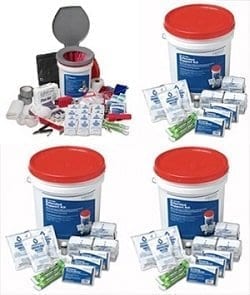Take these tips for sheltering in place so you can take the necessary actions for effective emergency management and survival!
Safety Tips and Guidelines for Sheltering in Place
What is sheltering in place? It is a short-term solution to address a chemical, biological, radiological, and nuclear threat where individuals seek shelter inside a nearby enclosed structure. The goal is to keep all contaminated outside air from seeping inside.
1. How to Shelter in Place at Work, at Home, or in Your Vehicle
You can be almost anywhere when the local authorities sound the alarm. Thus, it is best that you are knowledgeable enough to handle such a situation wherever you may be. Learn how to shelter in place wherever you find yourself whether at home or outside with this guide.
2. Check Your Home Emergency Kit
Other than the basics, your home emergency kit should contain pet food, OTC meds for your members with prescription needs, water purification tablets, anti-nuclear radiation potassium iodide tablets, and an ABC-rated Fire Extinguisher, just to name a few.
3. Include Documents in Your Emergency Kit
Important documents like medical and immunization records, insurance cards, spare keys, extra cash, and a map are essential elements that should be part of your emergency kit.

Most especially if you have a family member with serious/ongoing medical conditions.
4. Choose a Safe Room
If you can’t have a standard safe room installed, choosing a particular room in your home with the fewest or no windows at all is the next best thing. A master bedroom is an ideal location for a safe room.
5. Prepare a Safe Place for Your Pets
Make sure the safe place is pet-friendly. Get rid of any plants or toxic chemicals. Block places where your pets might get stuck in if they get frightened like vents or underneath heavy furniture.
6. Check for Warning Systems
It is important to know whether you can see and hear the warning systems in your locality. Your local government may have sirens or warning lights installed in your area. Knowing where these are and what they sound is critical for higher chances of survival.
7. Prepare a Family Emergency Plan
Advance preparation and constant shelter-in-place drills will make you and your family prepared with what to do, where to go, how, and where to find each other.

Most importantly, plot out how you can all communicate with each other if you part ways and need to seek shelter in another place.
8. Stockpile Adequate Supplies for You and Your Family
At least a 3-day supply will get you through such a situation.

Emergency and Disaster Preparedness for You and Your Family Photo by PaperSheepdog [Youtube]
Make sure you also have supplies for specific needs for persons with disabilities or medical needs.
9. Stockpile Bathroom Tissue
This item is often overlooked and somehow, preppers only realize its importance when it’s already too late. This will show you how to come up with a figure on how much tissue you should have in your stockpile.

Survival Stockpiling Tips: Bathroom Tissue Photo by Survival Life
It will also depend on how many people are in your house and how much BT you use on a daily basis.
You must have extra medical supplies just in case. Disposable gloves, rubber or nitrile gloves, N100 masks, and disinfectants such as hydrogen peroxide, alcohol, and bleach.
Other items such as duct tape, plastic sheeting material, and tarps are also equally important.
11. Invest in Solar Lanterns
Solar lanterns are the most effective and cheapest way to keep your home sufficiently lit during a blackout.

You would not worry about batteries anymore, and it should be bright enough for you to find your way around without stumbling.
12. Have a Store-a-Potty Ready
This 72-hour emergency toilet kit has an airtight lid, a snap-on toilet seat, a 3-day supply of biohazard bags, and deodorizer packets.

LifeSecure Extended Emergency Shelter-In-Place Combo Kit Photo by Life Secure
Other than making sure you have enough food and water, you can keep your health in tip-top shape through proper sanitation and hygiene.
13. Form a Personal Support Network
Support teams can consist of family, co-workers, friends, and caretakers. Inform them of your emergency plan and give them a set of extra keys to your home. Provide a copy of all important documents and medications to at least one out-of-state contact.
14. Prepare an Evacuation Plan
Once authorities order that it is clear to vacate the place where you’re sheltering you must know where to go next.

Prepare an Evacuation Plan Photo by Patio Drugs
Point out meeting places outside your neighborhood. Prepare alternate exit routes in case the areas you’re traversing might be inaccessible as well.
15. Close the Business or Worksite
This is the first thing you should do. First, ask the customers to stay. Then, list down all the names of those who are with you in the room.

Contact your business designated emergency numbers to let them know who is with you, after. Include their affiliation in your business as well.
RELATED: Roadside Emergency Kit You Need In Your Vehicle
16. Close and Activate the School’s Emergency Plan
This should be a plan that needs regular practice so students and faculty would know what to do in case of an emergency. Employees should be familiar with the building’s mechanical systems to turn them off and have it sealed immediately.
17. Stay in Your Vehicle
If it’s not possible to go to a building or your home, the safest and quickest way possible is for you to stay in your vehicle. Park in the safest place you can find. If possible, under a shaded area.

Turn off the engine, and close the windows and vents. Grab your emergency kit and listen to the radio.
18. Follow Protective Actions and Protective Actions Guides
The United States Department of Health and Human Services has a set of guidelines put together by the Radiation Emergency Medical Management or REMM.
What can you learn from the Radiation Emergency Medical Management (REMM) site? Find out –> https://t.co/Be6KFLhBal pic.twitter.com/MG1sfrCuPn
— HHS ASPR (@ASPRgov) December 15, 2015
This will enable you to follow various ways to protect your family if you need to seek shelter in another place.
19. Seal Doors, Windows, and Air Vents with Plastic Sheeting
Using duct tape and plastic sheeting seal all doors, windows, outlets, vents, and other possible entry points of outside air.
If plastic is not available, you can use a wet towel.
20. Turn Off Cooling, Heating, and Ventilation Systems
Never forget to switch off these systems first before sealing doors and windows. Doing so may bring contaminated outside air directly into your home. Don’t forget the fireplace damper as well.
21. Play the Game of Monkey See Monkey Do
This is for a typical school scenario. For a teacher, keeping the kids quiet and not worrying about their parents is quite difficult.

Play the Game of Monkey See Monkey Do Photo by Teach 123 School
Playing this game may somehow catch their attention and keep them still, thus avoiding many more unnecessary dangers.
22. Run-Hide-Fight
This is for a college setting with a shooter scenario. You will have to run to the nearest room, then lock the door behind you.
Take note to switch your phone to “silent or vibrate mode” while hiding under a desk or furniture. Should you be under imminent threat by the intruder, be ready to fight with anything you can use as a weapon.
23. Convert a Regular Wet/Dry Vacuum into an Air Filter
As long as the vacuum has a HEPA filter installed, it will clean out the air drawn from outside. The air that will exit the exhaust port and blow into the flow room will most likely be free of airborne viruses.
24. Wear an N95 Respirator Mask
This mask supposedly protects the wearer against airborne contaminants (0.3 microns in size) by 95%. Since it is disposable, it is best that you stockpile a few boxes for you and your family. This item should also be part of your emergency survival kit.
25. Stay Off the Phone Unless It Is Completely Necessary
Trying to contact your loved ones can clog up the telephone lines, which is critically needed by emergency personnel. Unless of course, it’s an emergency like a fire, police, or medical.

The school or workplace has systems for keeping your children or other family members protected if they need shelter.
26. Track Local TV and Radio Stations
Keeping updated on what is happening is important. This will enable you to make the necessary decisions that will make or break your and your family’s survival.

Monitor Local TV and Radio Stations Photo by CNN Media
Having an NOAA public alert radio is also important.
27. Prevent Boredom and Cabin Fever
Have board games, dance videos, playing cards, puzzles, and the like prepared to keep you and your family preoccupied while waiting for the clear out from authorities.

You’ll never know when you might need them. It may take longer than you expect.
28. Once Given the “All Clear” Signal
Before exiting the structure, open all doors, windows, and vents, and turn on the heating as well as the air conditioning system.

Let the air out while waiting outside for about 15 to 30 minutes before re-entering.
29. Evacuating After the “All Clear” Signal
Identify the paths to the nearest exit before the “All Clear” signal, first. Then, stay together and exit in an orderly fashion.

Never use the elevators, though. Finally, once you’re outside, account for every person present and immediately report any missing person.
30. Report to the Evacuation Reception and Care Center
Register your name even if you do not plan to stay there.

Report to the Evacuation Reception and Care Center Photo by Cowy Red Cross Blog
Family and friends who might be looking for you can proceed to the designated center. This will, in turn, make their search much easier.

Watch this video from Utah State University Extension and learn how to prepare to shelter in place:
These are just a few basic tips that will help you go through the before, during, and after sheltering-in-place emergency procedure. There are many more methods you can find over the internet should you want to know more details.
Overall, the ones aforementioned will surely be life savers for you and those around you. It is best to be ready even before a disaster happens.
You must have known some of these tips for sheltering in place before coming across this article. Tell us about it in the comments section below!
Up Next: 13 Winter Survival Methods To Keep You Warm
For awesome survival gear, you can’t make at home, check out the Survival Life Store!
Follow us on Facebook, Instagram, Twitter, Tumblr, and Pinterest!

Editor’s Note: This post was originally published on August 30, 2018, and has been updated for quality and relevancy.


























